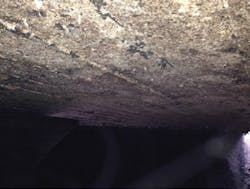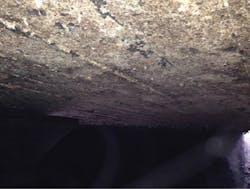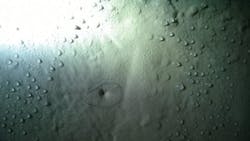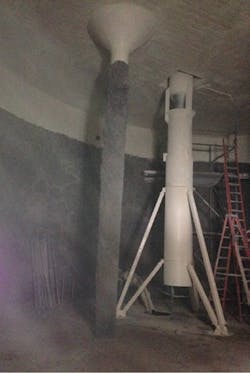Pressure Contained
Crews Stop Leak to Restore Decades-Old Digester Tank
Challenging Site Conditions Lead to Repair Trial and Error
By Greg Larson
Huddled inside a nearly 80-year-old anaerobic digester tank in the dead of a frigid Minnesota winter, contractors and engineers carefully inspected every square inch of the freshly coated concrete vessel, looking urgently for a hidden leak. On top of the digester’s cover, crewmembers braved wind chill temperatures exceeding -20°F as they watched for signs of the leak following both smoke and soap tests. Eventually, the crew found an unfilled cold joint tucked in a hard-to-reach area. This discovery allowed them to finally stop the leak and get the digester back into service — just in time to begin restoring a second digester that was almost 60 years old.
The concrete covers of the digester tanks were severely deteriorated with cracks allowing gases to escape and oxygen to enter the vessels. Numerous concrete “fins” (shown) from the original construction were difficult to coat and inspect.
Personnel from Minnesota-based Short Elliott Hendrickson Inc. (SEH), Champion Coatings, and Wapasha Construction, as well as local representatives from Sherwin-Williams Protective & Marine Coatings, were all involved in restoring the two domestic anaerobic digesters for the City of Austin, Minn. The concrete structures were severely deteriorated with numerous cracks in their covers, allowing gases to escape. Rather than level and rebuild the structures constructed in 1938 and 1959, the city was hopeful that high-performance protective coating and lining systems could extend the digesters’ lives. The winning bid team was confident this was possible, but it didn’t anticipate the numerous challenges it would encounter, including difficult site conditions, installation issues, and failed validation testing.
Answering an Urgent Need for Repairs
The City of Austin operates several anaerobic digesters to manage the breakdown of biodegradable waste from various industries. The process requires an oxygen-free environment to operate at peak efficiency so microorganisms can proliferate and rapidly break down waste. The deterioration was allowing gases to leak out of the digesters; it was also allowing oxygen to get in, making them increasingly inefficient.
Following the first application of the protective lining material, inspectors observed a few pinholes, which occurred due to outgassing inside the heated environment. Crews fixed these pinholes to ensure a uniformly-coated surface.
After the city drained and cleaned the 50-foot-diameter by 24-foot-tall tanks, engineers from the city, SEH, and Champion Coatings entered the structures to assess their condition. The inspection revealed that the concrete used in the 1930s and 1950s was still in great condition, but concrete used in the 1980s to rebuild the digesters’ mixer bases was severely deteriorated. In addition, inspectors observed cracking at the wall/cover interface of both vessels. After reviewing options, SEH specified two Sherwin-Williams products for the repairs: Dura-Plate® 235 Multi-Purpose Epoxy and SherFlex™ Elastomeric Polyurethane.
Making Repairs Under Difficult Conditions
The rehabilitation team initiated restoration of the first digester in mid-December 2014. Throughout the project, the contractors faced difficult operating and weather conditions, as well as a challenging tank design.
Initiating the restoration process, personnel from Champion Coatings removed loose debris and sandblasted the 4,000-square foot interior of the tank to prepare the surface of the deteriorated concrete to the SSPC-SP 13/NACE 6 standard for the coating and lining applications. Next, they applied a coat of Dura-Plate 235 as a primer for the entire structure, including both concrete and steel surfaces, as well as to control any potential outgassing. The coating provides exceptional performance in immersive and corrosive environments like a digester. It can be applied at temperatures as low as 0°F, making it highly suitable for the wintertime application.
The cold-season application was especially difficult due to frigid conditions. Inside the digester, crews ran heaters to make the environment more palatable for the coating applications. While the heat helped with application consistency, it created a minor problem of its own — the formation of some pinholes, which developed due to the heated environment encouraging outgassing.
Cold conditions also contributed to difficulties in applying the SherFlex coating and lining system. The product requires the use of a heated plural-component sprayer. With temperatures below zero, contractors had to wait up to two hours for the material to heat up before beginning applications. They then sprayed the product on the undersides of the concrete cover and the upper portion of the tank sidewalls to form a monolithic surface that would seal cracks in the concrete. The corrosion-resistant elastomeric polyurethane lining material bridges hairline cracks with a thick, flexible film that expands and contracts with the concrete substrate to minimize the chance of cracks forming in the lining.
The construction of the concrete tank cover caused additional challenges for the coating and lining applications, as the cover had numerous concrete “fins” that were difficult to coat and inspect. The fins were a remnant from the narrow wood forms used to construct the tank eight decades ago.
“We needed to build up a fully coated surface without pinholes to seal leaks and ensure waste material couldn’t get through to the concrete and promote corrosion,” said Gary Johnson, president of Champion Coatings. “Sealing off every sharp edge was tough, especially with the difficulties of getting the sprayer gun into tight spaces.”
Tucked in a hard-to-reach area, an unfilled joint was the culprit of a persistent leak that stymied the restoration team. After successfully filling the joint, the digester tank held pressure.
Testing — and Retesting — the Work
The project team understood that a successful digester repair meant the tank would no longer leak and therefore would hold pressure. SEH’s specification required the tank to be filled with water and pressurized to make this determination.
Unfortunately, the first pressure test failed. After draining the tank and performing troubleshooting, the team added additional coatings to the roof/wall juncture, thinking that the leak must be at that interface. The team also recoated some isolated pinholes. The crew then filled the tank with water a second time. Again, it would not hold pressure.
Engineers from SEH next tried a smoke test from the interior to see if they could identify leaks by standing on top of the cover and watching for smoke escaping. However, the thickness of the tanks prevented smoke from penetrating any remaining cracks. The engineers then tried a soap test on the tank’s exterior, ultimately discovering an area where the soap was bubbling to indicate where gas was escaping.
After draining the tank and conducting further inspections, the team ultimately located the hard-to-find trouble spot — which was about 10 feet from where the soap had bubbled on the exterior, as the air leak traveled along a joint before escaping outside. The source of trouble was a difficult-to-access cold joint that had been improperly filled since the time of the digester’s original construction. The coatings team carefully repaired the joint with SherFlex, refilled the tank with water, and were elated when the tank held pressure.
The fully restored and sealed cover enabled the digester tank to hold pressure and satisfy the project specifications.
“Restoring a digester tank typically wouldn’t be this difficult, but the age and construction of the vessels certainly contributed to the challenge of stopping all the leaks, as did the weather,” said Johnson. “Collaboration was vital to solving the leak issue and restoring the digester. Everyone worked together to give the owner the best possible outcome.”
Maintaining Poise Under Pressure
Due to the cold weather delays and repeated testing, troubleshooting, and repair processes, it took nearly six months to finalize the first tank and return it to service. With the lessons learned from that tank, the team made some adjustments and was able to repair the second tank much faster and without issues, completing it in November 2015. Both digester restorations will enable long-term service for the City of Austin.
“The coating and lining selection was a key to the success of the project,” said Joe Cesarak, a senior coatings specialist with SEH. “Because the team was able to completely seal the decades-old covers with these products, the city didn’t need to build new digesters. Instead, it can expect the restored vessels to continue operating for years to come.” WW
About the Author: Greg Larson is a senior representative for Sherwin-Williams Protective & Marine Coatings. He works with owners, engineers, contractors, and inspectors related to coating specifications, applications, and troubleshooting in all protective coating markets. He has over 24 years of experience and is a SSPC Level 1 and NACE Level III Certified Coatings Inspector. He can be reached at [email protected].




